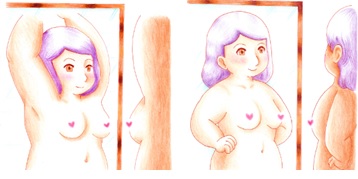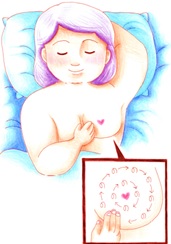What is Breast Self Examination (BSE)?

BSE is a simple breast inspection technique. This helps you to become familiar with the shape and texture of your breasts and to recognise any changes that may occur. This is especially important if you have lumpy breasts.
Why is BSE Important?
Breast health begins with good breast care.
Although there are many ways to lower your risk of developing breast cancer such as eating a healthy diet and keeping your skin around your breast moisturised, it is recommended for you to perform regular breast self examination.
Performing regular BSE is important for early detection of breast abnormalities such as breast cancer. Early detection increases your chances of a successful treatment.
How do I Perform a BSE?

Part 1 : Breast Self Assessment
Steps:
1.Stand in front of a mirror and turn slowly from side to side.
2.Adopt the following positions:
Look for visible changes in your breasts and nipples:
Shape: Your left and right breast may not be identical. Check for any changes in their size and shape.
Skin: Check for any changes in skin texture like puckering (small dent), dimpling (orange peel texture), rashes and redness to the surrounding area.
Nipples: Check if your nipples are turned inwards, if there are any redness, itching, swelling or any discharges.
Part 2 : Breast Self Examination

Lie down when you do this examination as it allows your breast tissue to spread out evenly across the chest wall and for easier detection of any abnormalities.
Feel for changes in your breasts, underarm and collarbone areas.
Steps:
Place a pillow under your right shoulder and rest your right arm behind your head.
Using the flat surface of your three middle fingers, apply light, medium, and firm pressure to your breast.
Start from the upper outer breast area and move gently to the center of your breast (your nipple). Use small circular motions in a clockwise direction to feel for any lumps.
Gently squeeze your nipple and check for any discharges.
Proceed to the underarm area and use the same techniques to feel for any lumps.
Repeat the above steps with the other breast.
Frequently Asked Questions
Q: Can I perform BSE in a standing position?
A: Yes, you can.
Q: When is the best time to perform a BSE?
A: The best time is five to seven days after your menses as your breasts will be less tender.
If you are no longer menstruating, perform the BSE on a fixed date every month.
Q: How frequent do I need to perform a BSE?
A: It is recommended to examine your breasts once a month.
Q: How long does a BSE take?
A: The process takes between 10 to 15 minutes.
Q: What should I do if I notice any changes?
A: If you notice any changes to your breast, call TTSH Breast Clinic to arrange for an review.
If you are not a patient of TTSH, you may proceed to your nearest polyclinic or general practitioner for a referral to see us.
Illustrations courtesy of PSA Chan Yee Wen
